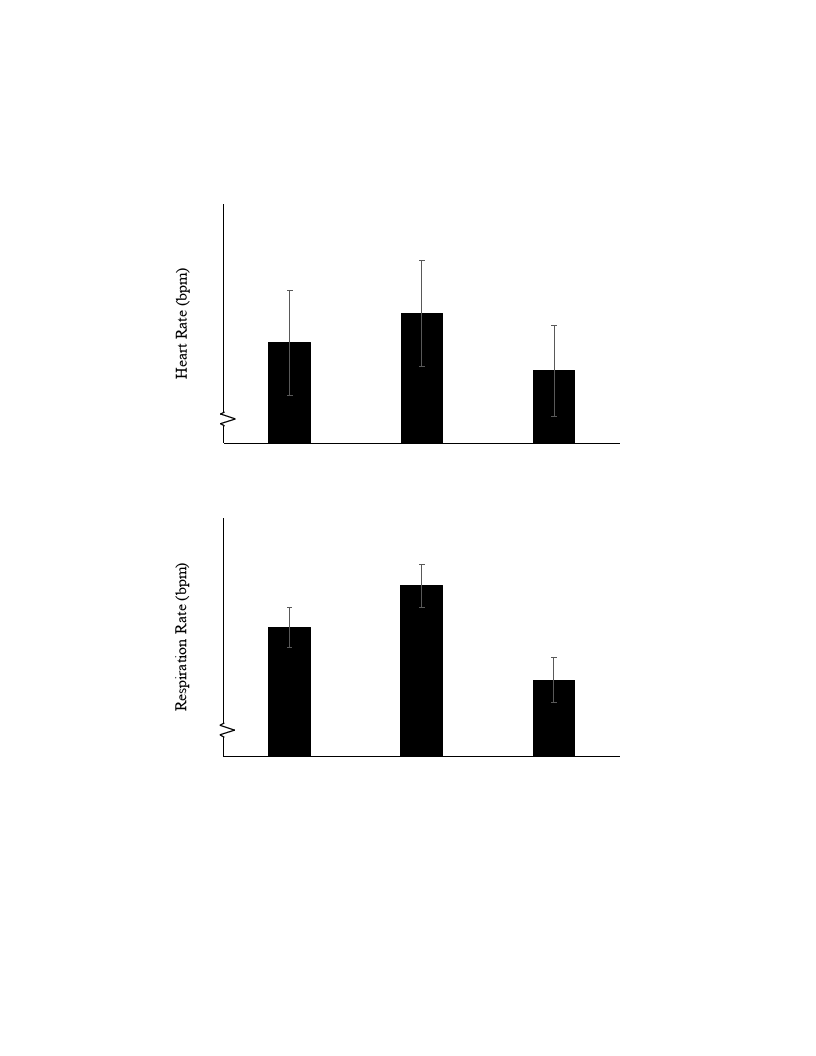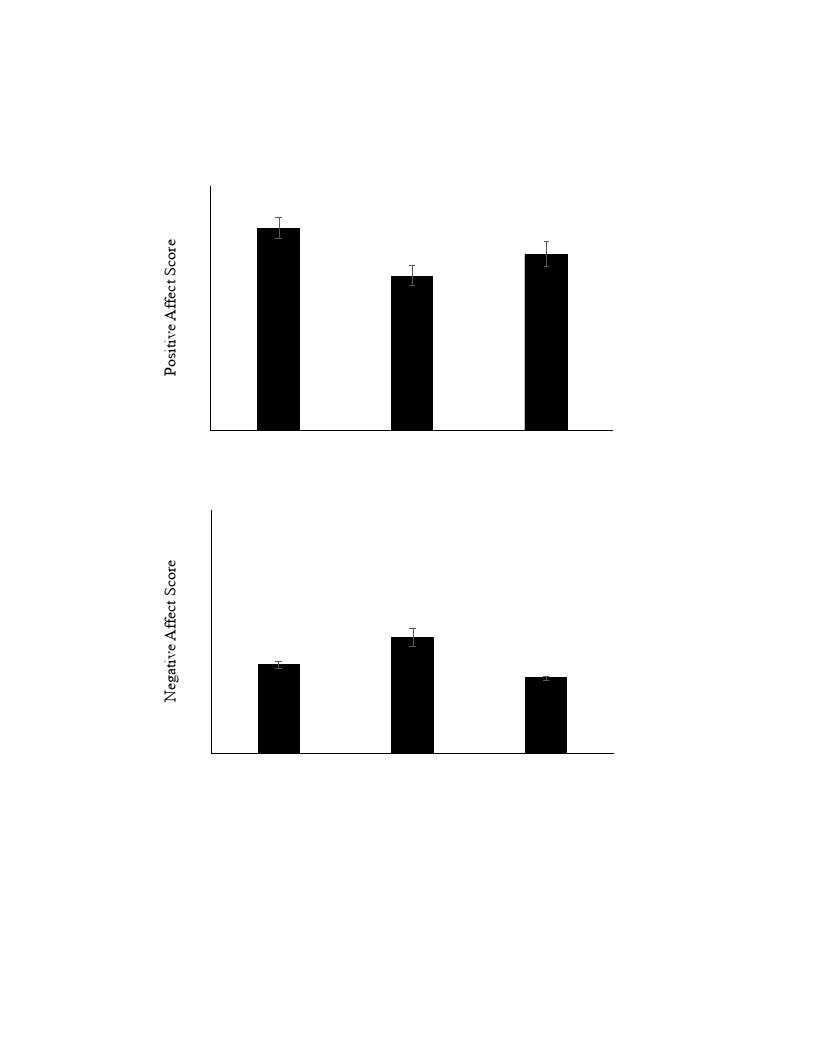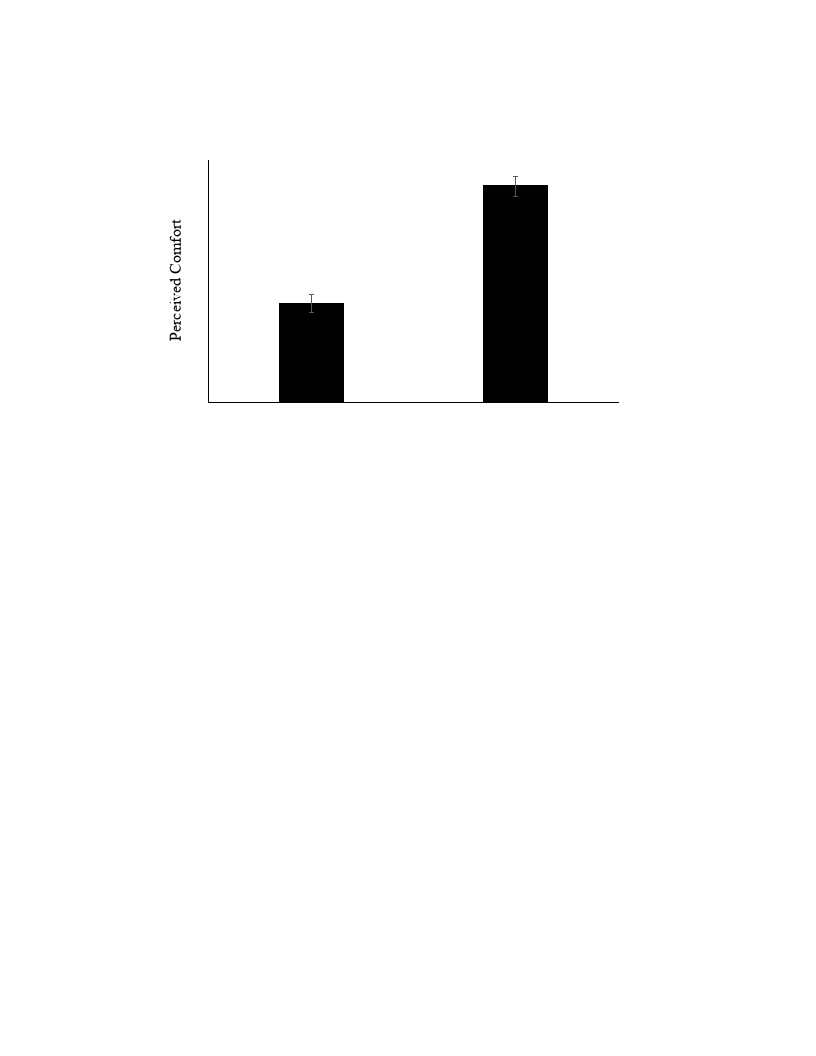
EFFECTS OF NATURE AND CITY SOUNDS ON PHYSIOLOGICAL AND
PSYCHOLOGICAL VARIABLES IN COLLEGE STUDENTS
Domenic DiPietro
A Thesis
Submitted to the Graduate College of Bowling Green
State University in partial fulfillment of
the requirements for the degree of
MASTER OF SCIENCE
December 2020
Committee:
Maria G. Bidart, Advisor
Verner Bingman
Daniel Wiegmann

© 2020
Domenic DiPietro
All Rights Reserved

iii
ABSTRACT
M. Gabriela Bidart, Advisor
With an increasing human population, there are more densely-populated urban cities.
Although this supports our gregarious lifestyles, it consequentially inhibits our contact with
nature. This study focuses on the effects of different types of sounds on physiological and
psychological variables in college students. Specifically, nature sounds (a mixture of birdsongs
and water sounds) and man-made, city sounds (a mixture of traffic, construction, and siren type
of sounds) were evaluated for their potential effects on heart rate, breathing rate, and emotional
states using the Positive and Negative Affect Schedule (PANAS) questionnaire. Participants
included 20 female students ranging from 18-28 years old. Using a within-subject design, each
participant was assigned to listen to both a 7-minute segment of nature sounds and a 7-minute
segment of city sounds (order of type of sounds was randomized). Sound volume was set at
approximately 70 dB (conversational volume) through their own device and headphones. All
dependent variables were recorded manually before the sound intervention and after each of the
two sound treatments. Since this study was performed throughout the COVID-19 global
pandemic, each experimental trial was performed remotely over a WebEx virtual conference, and
variables were self-recorded by each of the participants. Results showed that a seven-minute
segment of nature sounds significantly decreased respiration rate (P < 0.0001) and negative
affect schedule score (P < 0.0001) when compared against a seven-minute segment of urban
sounds. Additionally, a survey prior to sound treatments revealed that participants had a higher
preference for nature than for urban environments (P < 0.0001). Future research would help

iv
further understand variability in physiological responses, as well as human preferences for
different types of sounds.

v
I dedicate this thesis to my parents, who have given me unconditional love, support, and the
belief that we are all life-long learners, regardless of our endeavors.

vi
ACKNOWLEDGMENTS
I cannot extend enough thanks to my advisor, Dr. M. Gabriela Bidart, for her unending
support and patience throughout my graduate pursuits. Her patience through our hurdles,
solutions to common problems, knowledge in the field of science, and unending aid have been
invaluable through both my academic and social lives. I am fortunate to have her as a mentor as
she has helped confirm that I love working as a scientist.
I would also like to thank my committee members, Dr. Daniel Wiegmann and Dr. Verner
Bingman for their inputs, advice, support, and adaptability throughout my graduate experience.
I’d also like to thank my lab mates Claire Thelen, Lauren Greenwell, and Kelsey Dietrich for
their feedback, opinions, and tremendous help with brainstorming ideas and broadening my
horizons.
A big thank you to my friends and family who have helped keep me grounded with
motivation, fellowship, and the subtle reminder of the importance in quality of life. I’d like to
specifically mention Isabella DiPietro, Liam DiPietro, Michael Sheehan, and Michael March for
my special ties to them. Daniel Walton gets thank you for introducing me to Ableton Live and
its cross compatibility with files. Finally, a special thanks to Abigail Jarosz for reminding me to
eat, get some sleep, being a guinea pig for trials, and enjoying my quarks in lab and life.

vii
TABLE OF CONTENTS
Page
INTRODUCTION ............................................................................................................... 1
MATERIALS AND METHODS ......................................................................................... 5
Participants and Recruitment .................................................................................... 5
Experimental Sounds ................................................................................................ 6
Experimental Design ................................................................................................ 7
Statistical Analysis ................................................................................................... 9
RESULTS......…….................................................................................................................. . 10
DISCUSSION......……............................................................................................................. 12
LITERATURE CITED ........................................................................................................ 18
APPENDIX A. PARTICIPANT INFORMED CONSENT ................................................... 25
APPENDIX B. BASELINE QUESTIONNAIRE ................................................................. 27
APPENDIX C. POSITIVE AND NEGATIVE AFFECT SCHEDULE (PANAS)
QUESTIONNAIRE......…….................................................................................................... 28
APPENDIX D. PARTICIPANT INSTRUCTIONS FOR ONLINE LOUDNESS METER ... 29
APPENDIX E. FIGURES...................................................................................................... .. 30
APPENDIX F. TABLES.…..................................................................................................... 33

1
INTRODUCTION
There has been a growing interest in enhancing our relationship with nature around the
world in the past few decades. Originating almost 40 years ago in Japan, the practice of Shinrin-
yoku, translating to forest-air bathing, relates to the experience of individuals immersing into a
natural environment (Hansen et al. 2017). This activity is broadly thought to increase our overall
wellness (Park et al. 2010). Forest bathing is still a relatively new research topic, and the
scientific and medical communities are just beginning to ascertain how to implement shinrin-
yoku as a natural, wellness medicinal approach (Largo-Wight et al. 2016).
There are a few challenges related to the modern world that may interfere with humans’
potential for reconnecting with nature. Access to natural areas with plants and wildlife may be
difficult to find; especially, for individuals living in metropolitan areas (Hoffimann et al. 2017).
According to the United States 2010 Census, 80.7% of the population lives in an urban area or
cluster (“Urban Areas Facts” 2018). When compared against each other, individuals in a forest
setting have significantly lower risks of cardiovascular disease than those in a city environment
(Hassan et al. 2018). Among recent studies, rapidly urbanizing areas are changing the selective
pressures of animal populations around them (Tüzün et al. 2017). Plants also change in
responses to the presence and abundance of pollinators in a certain area (Veits et al. 2019). If
availability of parks and wildlife is scarce, the next best option would be to create more natural
areas with gardens in outdoor settings, which can still boost activity levels and wellness for
humans (Wolf 2008). An abundance of outdoor plants attracts positive attention, and can also
increase property values, especially in urban areas with dense populations and construction sites
(Wolch et al. 2014). City designers and organizers may avoid incorporating too many trees in an
urban environment due to potential risks related to branches falling or high maintenance,

2
especially if trees are closer to the road or electrical poles (Dixon and Wolf, 2007). However,
completely removing trees and plants from cities can have negative effects on human health
(Grinde and Grindal, 2009). The lack of green landscape can cascade along with other problems,
such as financial or personal struggles, which can all influence stress levels in humans (Wolch et.
al., 2014). Those who are immersed in a green environment may feel less stressed than those
living in a completely urban landscape (Mitchell and Popham 2008). From a commissioner’s
standpoint, there are still ways to receive the benefits of nature without sacrificing roads and
economic space. Strategically placing plants in urban communities may induce a greater
parasympathetic nervous system activity, and thus, relaxation, while decreasing sympathetic
nervous system activity associated to stress responses (Park et al. 2010).
From a fiscal point of view, having plants in a workplace can boost creativity and
cognitive function (Mangone et al. 2017). This general nature exposure can subconsciously
influence daily decisions as fundamental as where people would want to shop (Wolf 2007).
Findings generally show that stores with a more “biophilic” design yield greater satisfactory
ratings by consumers (Joye et al. 2010). This connects with other findings such as how tree
canopy area is significantly correlated to perceived general health (Maas et al. 2006). With such
a positive influence of nature exposure, it may be a good effort to amend our seclusion from
green spaces.
Positive effects of nature on humans is induced by sensory signals. A nice view, bird
songs, water sounds, the scent of plants and flowers can stimulate relaxation. Although full
immersion in nature (with all senses) would be best, individuals can still reap benefits from
artificial and partial exposure to nature (Wackermannová et al. 2016). Sounds that relax us can
be associated with natural environments that potentially maximize the effectiveness of auditory

3
stimuli. Videos and images of natural environments are known to ease a stressed state (Ulrich et
al. 2008). Additionally, nature sounds and scents may provide just as many benefits as visual
stimuli (Franco et al. 2017). Nature sounds may be similar than effects of music on humans.
Some studies show that music can lessen the impacts of a stressful event, (Thoma et al. 2013).
Those suffering from depression and other psychological conditions can be calmed by music
therapy (Ray and Götell, 2018). These auditory relaxers may have a wide range of variability as
bias of musical preference could skew results from subject to subject (Gruhlke et al. 2017). The
benefit of certain sounds, such as natural running water, may even be more beneficial than
listening to soft music, and could be linked to human evolution in natural environments (Thoma
et al. 2018). In a society where urbanization is expanding, maximizing the integration of urban
areas with nature can be of major psychological benefit (van den Berg et al. 2007). These
patterns suggest that negative effects of daily stressors, in the absence of direct access to nature,
may be alleviated by simply listening to recordings of nature sounds, and/or videos incorporating
both auditory and visual stimuli.
Traffic, for example, can be a seemingly unavoidable daily encounter for populations in
metropolitan areas. The noises alone from traffic can insinuate stress (Franek et al. 2017).
Individuals walking with the sound of traffic walk significantly faster than in an alternate route
of equal distance with forest birdsong (Franek et al. 2017). After applied auditory stressors,
nature sounds can quickly help individuals to relax (Alvarsson et al. 2010). In addition, nature
sounds played before a stressful experience; like surgery, can significantly reduce patient anxiety
(Amiri et al. 2017). With an array of situations in which natural sounds can help, we may
wonder why we don’t see “more nature” in our urbanized environments. With an ever-
increasing demand for urbanization, it can be very difficult for some individuals to have the

4
opportunity to be immersed with nature (Hoffimann et al. 2017). For these individuals, listening
to nature sounds could be a potential way to gain some of the benefits of nature on health and
cognition (Hedger et al. 2019). A recent study has showed that nature sounds can significantly
reduce physiological stress after just seven minutes of exposure (Largo-Wight et al. 2016).
The main goal of my research was aimed at evaluating the effects of different types of sounds
(i.e., nature and man-made sounds) on physiological and psychological responses of female
college students. With the challenges that arose with the COVID-19 pandemic, the original
research plans had to be modified to be completed remotely. I evaluated the effect of (i) a
mixture of nature sounds including water sounds and birdsongs, and (ii) a mixture of urban
sounds including heavy traffic and sirens) remotely, using videoconference meetings as trials.
While it can be predicted that a mixture of nature sounds can be perceived as more relaxing than
a mixture of urban sounds, it can be expected there could be a range of variability due to
individual preferences or differences in the perception of the distinct sounds from subject to
subject. Among our rapidly urbanizing population, some bird species are changing their song
repertoires, which may differ from those present at the times of our human ancestors (Deonizak
& Osiejuk, 2019). Additionally, acute lethargic, anxiety, or depressive-like symptoms are
reported in some individuals among our coronavirus epidemic (Wang et al. 2020). This research
study will provide important information regarding how different environments (i.e., nature
versus urban environments) may affect physiological and psychological responses of human
subjects, which could be related to stress or relaxation. This information could be further applied
to boosting cognitive performance (Van Hedger et al. 2019), and general wellness (Thoma et al.
2018) while, for example, creating a working from home environment.

5
MATERIALS AND METHODS
Participants and Recruitment
The research population for this study included 20 female university students from 18 to
28 years of age. Upon completion of training and proposal submission, the Bowling Green State
University Institutional Review Board (IRB) approved this project #1502803. Recruitment
included approved text for emails and university announcements, in addition to giving
information through BGSU online classes via canvas course shells. Along with recruitment text,
each participant received PDF of the IRB stamped consent form (Appendix A) for a full
description of minimal risk, confidentiality, and the voluntary nature of the study. If the
contacted individuals expressed interest, they were allowed to select a meeting time on any
weekday at 6, 7, or 8 pm. Upon confirmation of a time for a WebEx meeting, each participant
was emailed the files they would need for the study. These files included the sound mixes, a
consent form as a Word document that each participant could sign, and a template to insert
physiological and psychological measurements taken by the participant during the study. In
addition to sending all these files to the participants, the researcher directly guided them through
each recorded activity via WebEx teleconference meetings.
Twenty-four hours before each trial, the participants were asked to avoid eating foods
with excessive amounts of carbohydrates, as well as consuming a regular amount of caffeine in
accordance to their individual, daily routine. An initial questionnaire (Appendix B) was
completed after the consent form to ensure there have been no abnormal changes in diet, rest, or
physical activity that could alter physiological or psychological measurements.

6
Experimental Sounds
All sounds used were specifically collated for this study. Seven individual sound
segments were acquired through “Freesound.org.” Three sound segments were used for the mix
of nature sounds and four sound segments were used for the mix of urban sounds. Nature sounds
consisted of birdsong and running stream water (Appendix D), while urban sounds included
traffic, construction, and sirens (Appendix D). Six out of the seven sounds are under the
“Creative Commons 0,” without copyright license, as the creators have included them on
freesound.org as public domain for free and open use. The last sound fits under the attribution
category of “Creative Commons Use.” Under this license, credit is given to sound creator,
Klankbeeld (https://freesound.org/people/klankbeeld/) for the production of one of the sounds
used in the urban sound mix for this study. A link to the attribution and license is required and
included herein (https://creativecommons.org/licenses/by/3.0/).
Each of the six sounds were normalized using the free software, Praat, to equalize them
to the same average volume of 70 dB. These normalized files were then assembled together
using the standard version of sound software Ableton Live 10 using a MacBook Pro Model
A1502 (Apple, Cupertino, CA, USA). In the sound software, volumes were slightly modified,
each segment was repeated, and the collection of each of the segments was grouped to be
exported as an mp3 file to be sent to the participants. With the restriction of file size capabilities
in an email, mp3 files were used instead of wav files. Each sound segment was set to 7 minutes
following methods by Largo-Wright et al. (2016), since they found this amount of exposure to be
effective to significantly reduce physiological stress in a similar setting (after a “brief nature
sound intervention”). Both of the urban and nature sound files were exported so that they had

7
the same average and peak dB values. This ensures that when they were sent to each participant
as separate mp3 files, the urban and nature sounds were heard at the same volume.
Experimental Design
A within-subject approach was used to evaluate the effects of nature and man-made city
sounds on physiological and psychological measurements in human subjects. This study was
completed during the COVID-19 pandemic, so all contact with the participants was virtual,
including classroom recruitment through Canvas course shells, email communication, and
videoconference meetings via WebEx. Each participant was only asked to participate in a single,
one-hour meeting that was used for instruction, listening to the sounds, and self-recording of
their heart rate and breathing rate, as well as completing the Positive and Negative Affects
Schedule (PANAS) survey after listening to the nature and city sounds. In addition, two
questions related to perception of the two environments (perceived comfort) were responded by
participants before the sound trials.
Following a within-subject design, each participant listened to both the mixture of nature
sounds and the mixture of city sounds. For counterbalancing, the order was randomly assigned
using a random integer generator within a TI-Nspire CX CAS (Texas Instruments, Dallas, TX,
USA). In each trial, there was a 10-minute period between listening to sounds to allow for the
participants’ vital signs to return to baseline.
Dependent variables were recorded at the beginning of the study, as a baseline, and then
immediately, after each of the 7-minute sound segments. Heart rate was recorded by the carotid
pulse. The researcher instructed subjects to manually record their heart rate by placing their
middle and index fingers to the side of their windpipe for 15-seconds. Time was kept by the
experimenter, giving signals to start and stop counting. Similarly, each participant was asked to

8
count the number of breaths they took in 60-seconds. For this purpose, participants were asked
to count the number of times that they inhaled (i.e., every time the chest/abdomen rises). When
both physiological vitals were successfully recorded, each participant completed the PANAS
survey. The PANAS is split into the positive affect score (PAS) and the negative affect score
(NAS). The PAS has ten emotions associated with positive mood are given a score from one to
five in order to evaluate each participant’s mood state. A sum of each of the ten positive
emotions then conveys the PAS score with a higher score signifying a more positive mood.
Similarly, the NAS also has ten emotions in which participants record a score from one to five on
relative feeling. The sum of these ten scores results in the NAS score in which higher score
signifies a more negative mood. The visual template participants used is shown in Appendix C.
In addition, before the sound trials started, as part of some general questions (Appendix B), the
participants answered two questions related to perception of the two types of sounds using a
Likert scale of 1-7 (1 = very stressful and 7 = very relaxing). To achieve a comfortable volume,
a free online loudness meter, created by Youlean, was used. Each subject was asked to use
headphones to mitigate auditory distraction from their surrounding environment. Prior to
listening to the sounds, participants were asked to follow these directions to achieve a playing
volume that would have no risk to damaging their hearing:
1. On a smartphone or tablet device separate from the one you’re using for your sounds, go
to the following url:
https://youlean.co/online-loudness-meter/
2. Allow the website to use your device’s microphone
3. Open the NatureSounds.mp3 file and play it from the device you’ll be playing the sounds
from through your headphones
4. Hold your headphones around the speaker using the Youlean loudness meter

9
5. Adjust your sound volume on your device so that the average is approximately 70 dB
Each time you change the volume, click/touch the “X” on the loudness meter.
This restarts the meter so you get a new average
6. It’s crucial that you don’t change your computer’s volume for the rest of the study.
An average of 70 dB was chosen as it resembles conversational volume. Peak volumes in both
mixes did not pass 87 dB. At 90 dB, potential hearing damage could occur only after 8 hours of
continuous exposure, so all participants were completely safe throughout the study. While
listening to each of the sound segments, participants were asked to keep their eyes open, remain
in a seated and neutral position, and to concentrate on the sounds as best as they could.
Statistical Analysis
The data generated from this research project were statistically analyzed using SAS
Software. version 9.4 (SAS Institute, Cary, NC, USA). Analyses of Variance were conducted to
test for the effects of the sound treatments (i.e., nature and city sounds) and subjects on vital signs,
and PANAS scores. When assumptions of normality and heterogeneity of variance were not met,
data were rank-transformed. Pairwise comparisons among treatment means were performed using
Fisher’s Least Significant Difference tests when ANOVA models were significant (protected
LSD). In addition, a measure of perceived comfort with city and nature sounds before the sound
trials was analyzed using a Kruskal-Wallis test.

10
RESULTS
Results from this study provide evidence of how participants differentially responded to
nature and city sounds both psychologically and physiologically. Analyses of variance
(ANOVA) showed no significant effects of the sound treatments on heart rate (F2, 38 = 2.99; P =
0.0625) (Figure 1 a), but significant effects between subjects (F19, 38 = 25.59: P < 0.001).
There were, however, statistically significant effects of treatments and subjects on respiration
rate (Treatment: F2, 38 = 12.87; P < 0.0001; and Subject: F19, 38 = 6.06; P <0.0001). Multiple
comparisons among treatment means showed that respiration rates after listening to nature
sounds were significantly lower (by 23%) from those after the city sound intervention. Baseline
measurements were not statistically different than either of the two sound interventions (Figure 1
b).
Psychological measures of positive and negative affect schedule (PANAS) scores
differed after city and nature sounds. PANAS scores include positive affect scores (PAS) and
negative affect scores (NAS) (Table 1). The effect of sound treatments significantly influenced
total PAS (F2, 38 = 15.72; P < 0.0001). Comparisons of the means showed that listening to city
sounds induced a decrease in the mean total PAS of the participants, which was 23.4% lower
than baseline scores (Figure 2 a). However, mean PAS after nature sound intervention was not
significantly different from either of the other two groups. For total NAS, there was a significant
effect of sound treatment (F2, 38 = 24.84; P < 0.0001), but no significant results for subjects
(F19,38= 1.73; P < 0.0752). Pairwise comparisons revealed that mean total NAS after city and
after nature sounds were significantly different from each other and from baseline scores. Mean
total NAS of participants increased by 31.1% (from baseline) after listening to the city sounds,
while listening to the nature sounds yielded a 14.9% decrease in negative affect scores (Figure 2

11
b). The measure of “perceived comfort” with the two types of environments prior to the sound
trials was also statistically significantly different (F1, 19 = 52.22; P < 0.0001). As shown in
Figure 3, the average Likert scale perception of city sounds before the start of the sound trials
was 2.85 while the average perception of nature sounds was 6.25 indicating that nature sounds
were perceived as more “comforting” than city sounds.

12
DISCUSSION
Previous studies have evaluated the effects of human physiological and psychological
responses to the environment (Grinde & Patil, 2009; Beatley, 2011; Franco et al. 2017). Most of
these studies explored the effects of urban and natural environments in a fully immersive way, in
which the environments stimulate several senses simultaneously (e.g., sight, sound, and smell).
The present study focuses on auditory stimuli, which is processed initially through the primary
auditory cortex (A1), and these findings are the first to explore how humans react to urban and
natural auditory stimuli remotely, from a home rather than a lab setting. Results showed that
listening to pre-recorded nature sounds induced a significantly lower respiration rate (Figure 1 b)
and Negative Affect Score (NAS) (Figure 2 b) than city sounds. This outcome agreed with a
survey completed before the sound interventions in which participants showed a higher
(statistically significant) preference for nature over city sounds (Figure 3). As a whole, these
results suggest that humans still have a positive, innate connection to green spaces and natural
environments. Thus, reconnecting with nature can result in benefits to the mind and body,
especially for those living in densely-populated areas.
Overall, the experimental results suggest that the sounds of an urban area have different
effects on human psychology and physiology than the sounds of a natural environment. From
the two physiological variables measured (i.e., heart rate and respiration rate), heart rate, was the
only variable in this study that was not significantly influenced by the different sound
interventions (Figure 1 a). A previous study by Gee et al. (2019) also showed a lack in
significant changes in heart rate, but an improvement with anxiety and mood when participants
observed aquariums with live fish, plants, and water while in a laboratory setting. The lack of
significance results from this study could be primarily due to a large variability in heart rate

13
across participants (significant within-subject effects on heart rate). Individual measurements
ranged from a minimum of 56 bpm to a maximum of 136 bpm. In addition to variability, heart
rate naturally changes very rapidly, and although it was measured immediately after each sound
intervention, some of the participants struggled to quickly find their carotid pulse.
The other physiological variable measured for this study was respiration rate. Lower
respiration rates suggest activation of the parasympathetic nervous system (PNS), which is the
part of the autonomic nervous system (ANS) responsible for relaxation. This occurs through
vagal activity, as the vagus nerve is a major conduit between the lungs and the brain (Geus et al.
1994; Chang et al. 2015). In contrast, the sympathetic nervous system (SNS) is the part of the
ANS that is activated by stressful situations. Activation of the PNS alleviates negative effects of
stressors by reducing SNS activity, and thus, balancing ANS responses, which leads to
relaxation. Comparisons among treatment means in this study showed that mean respiration rate
after listening to a seven-minute segment of city sounds was significantly higher than the mean
respiration rate after listening to a seven-minute segment of nature sounds (Figure 1 b). The
respiration rate from this study is in accordance with similar studies by Fuertes et al. (2014) and
Kondo et al. (2018), as participants in green spaces recorded lower respiration rates and fewer
chronic health complications when compared to participants in urban environments. The
findings from this study suggest that individuals who are stressed in urban areas and don’t have
access to parks may benefit from listening to pre-recorded nature sounds to help activate their
PNS and drive relaxation responses.
As part of the peripheral nervous system, PNS and SNS also influence psychological
states as happy or relaxed moods are congruent to PNS activity. Contrarily, anxiety and
depressive feelings can be associated with a SNS stress response. For this study, psychological

14
state was measured using the Positive and Negative Affect Schedule (PANAS) questionnaire.
This questionnaire gives a list of emotions that, when scored, give a positive affect score (PAS)
and a negative affect score (NAS). In this study, PAS has a significant decrease from baseline
measurements after listening to the seven-minute segment of city sounds (Figure 2 b). This
result is in accordance with a study by Berman et al. (2012), in which the PANAS questionnaire
was used to discover an improvement in mood for participants in natural settings. For the results
of this study, multiple comparisons among means showed no significant differences in PAS
means between the after-nature sound intervention and the other two groups. The significant
decrease in PAS after the city sound intervention suggests that urban sounds may trigger stress
responses that decrease positive emotions. This could result in a negative effect on work ethic,
compassion, and purpose in an urban environment (Lumber et al. 2017; Mitchell & Popham,
2008).
In contrast to positive mood states, negative affect scores (NAS) were significantly
higher after the city sound intervention, but significantly lower after listening to seven minutes of
pre-recorded nature sounds (Figure 2 b). Like PAS, the NAS results were in accordance with the
study by Berman et al. (2012), where NAS scores were higher in urban environments and lower
in natural environments. Higher NAS scores suggest that humans have a more negative, stressed
mood when in an urban setting. For this study, specifically, the NAS after the seven minutes of
nature sounds scored a 10.8 0.32. This result is close to the minimum possible for NAS, as
PANAS scores range from ten to fifty. In contrast, low NAS scores after the nature sound
intervention suggests that listening to a pre-recorded set of natural sounds in any situation may
help mitigate the effects of negative emotions. Minimizing the feeling of negative emotions

15
likely results from the deactivation of the SNS and engagement of the PNS; thus, balancing the
autonomic nervous system and relieving stress-related symptoms.
In addition, this study evaluated innate preferences of participants for urban or nature
environments before the sound interventions. There was a statistically significant difference
between perception of the two environments (Figure 3), with a higher preference for nature
sounds (i.e., all but two participants chose a six or seven on a Likert scale of one to seven). This
is in agreement with similar studies in which natural sounds and environments were preferred to
city workspaces (van den Berg et al., 2007; Hunter & Askarinejad, 2015; Mangone et al., 2017).
The preference for nature may derive through experience as well as evolutionary history (Blades,
1989; Orri et al. 2019). Humans may have an innate connection to natural environments as our
ancestors evolved in direct contact with nature and gathered in small groups. However, the effect
of experience, whether children are raised in an urban or rural community, may influence
subsequent preferences later in life (Cohen & Horm-Wingerd, 1993). Results from this study
suggest that humans may still perceive natural environments as more relaxing and linked to less
negative emotions.
Due to the Covid-19 pandemic, this study was completed remotely. Although participants
had the benefit of completing the sound trials in the comfort of their own homes, there are a few
difficulties related to working remotely. Communication with each participant was mostly done
via email, with the only visual and voice contact being through the WebEx videoconference call
during the trial. Additionally, each participant used their own device and headphones to play
sounds. Across operating systems and brands, the free Youlean loudness meter did not always
work efficiently for each participant. Some participants experienced the 70-dB level reading on
this meter as somewhat uncomfortably loud. In these cases, the participant was asked to modify

16
the volume of their devices to a level they would consider to be a comfortable, normal
conversational volume. Although this volume might not have been exactly 70 dB, the goal was
that every participant would at least perceive the volume as “conversational” volume. So, we
assume that volume level was set by each participant to an average of 70 dB. The reliance on
each participant to record their own physiological vitals might have also been subject to some
random error, but with the aid of the experimenter guiding students through these tasks, and
keeping the time for the measurements, random effects should have been minimized. As a final
note, having a within-subject design led each trial to be just under an hour. A few participants
had notes that mentioned their fatigue on the second set of sounds (determined by a random
number generator). This case was rare as most participants commented on how quick the trial
seemed to last. Generally, it is also important to note a potential bias in terms of sound
perception that humans may experience. Associations with sounds may be linked to different
cultural perceptions across the world, with over 6,000 languages spoken and the difference in
cross-modal mappings as a result of nonarbitrary associations (Blasi et al. 2016).
Despite the problems that come with virtual research, there is the potential of finding
accessible tools that could improve general feelings of well-being during a global pandemic.
Amongst the challenges that COVID-19 has brought, individuals have been forced to isolate
themselves and many may have limited access to natural space. Finding accessible ways to
nature may help to cope with potential negative psychological effects related to a global
pandemic (Xiao et al. 2020). Those who are experiencing elevations in anxiety and don’t have
access to natural spaces could use these findings to explore whether recordings of sounds from
natural environments may bring some relief by engaging parasympathetic nervous system
activity and deactivating the sympathetic nervous system, which is associated to stress responses

17
(Hoffman et al. 2017). However, humans may have different preferences for a single, dominant
sense, and nature sounds may not be relaxing for everyone (Zurek 1993; Lakie & Loram, 2006).
In any case, a full immersion in nature, as happens during a walk in the woods, may override a
single dominant sense and help to reconnect with our roots in nature.

18
LITERATURE CITED
Alvarsson, J. J., Wiens, S., & Nilsson, M. E. (2010). Stress recovery during exposure to nature
sound and environmental noise. International journal of environmental research and
public health, 7(3), 1036-1046.
Amiri, M. J., Sadeghi, T., & Bonabi, T. N. (2017). The effect of natural sounds on the anxiety of
patients undergoing coronary artery bypass graft surgery. Perioperative Medicine, 6(1),
17.
Beatley, T. (2011). Biophilic cities: integrating nature into urban design and planning. Island
Press.
Berman, M. G., Kross, E., Krpan, K. M., Askren, M. K., Burson, A., Deldin, P. J., Kaplan, S.,
Sherdell, L., Gotlib, I. H., & Jonides, J. (2012). Interacting with nature improves
cognition and affect for individuals with depression. Journal of affective
disorders, 140(3), 300–305. https://doi.org/10.1016/j.jad.2012.03.012
Blades, M. (1989). Children's ability to learn about the environment from direct experience and
from spatial representations. Children's Environments Quarterly, 4-14.
Blasi, D. E., Wichmann, S., Hammarström, H., Stadler, P. F., & Christiansen, M. H. (2016).
Sound–meaning association biases evidenced across thousands of
languages. Proceedings of the National Academy of Sciences, 113(39), 10818-10823.
Chang, R. B., Strochlic, D. E., Williams, E. K., Umans, B. D., & Liberles, S. D. (2015). Vagal
sensory neuron subtypes that differentially control breathing. Cell, 161(3), 622-633.
Cohen, S., & Horm-Wingerd, D. (1993). Children and the environment: Ecological awareness
among preschool children. Environment and behavior, 25(1), 103-120.

19
de Geus, E. J., Willemsen, G. H., Klaver, C. H., & van Doornen, L. J. (1995). Ambulatory
measurement of respiratory sinus arrhythmia and respiration rate. Biological
psychology, 41(3), 205-227.
Deoniziak, K., & Osiejuk, T. S. (2019). Habitat-related differences in song structure and
complexity in a songbird with a large repertoire. BMC ecology, 19(1), 40.
Dixon, K. K., & Wolf, K. L. (2007). Benefits and risks of urban roadside landscape: finding a
livable, balanced response. In 3rd Urban Street Symposium: Uptown, Downtown, or
Small Town: Designing Urban Streets That WorkTransportation Research BoardInstitute
of Transportation Engineers (ITE) US Access Board.
Franco, L. S., Shanahan, D. F., & Fuller, R. A. (2017). A review of the benefits of nature
experiences: more than meets the eye. International journal of environmental research
and public health, 14(8), 864.
Franek, M., Režný, L., & Cabal, J. (2017). Effects of traffic noise and relaxation sounds on
pedestrian walking speed (No. e3475v1). PeerJ Preprints.
Fuertes, E., Markevych, I., von Berg, A., Bauer, C. P., Berdel, D., Koletzko, S., ... & Heinrich, J.
(2014). Greenness and allergies: evidence of differential associations in two areas in
Germany. J Epidemiol Community Health, 68(8), 787-790.
Gee, N. R., Reed, T., Whiting, A., Friedmann, E., Snellgrove, D., & Sloman, K. A. (2019).
Observing live fish improves perceptions of mood, relaxation and anxiety, but does not
consistently alter heart rate or heart rate variability. International Journal of
Environmental Research and Public Health, 16(17), 3113.

20
Grinde, B., & Patil, G. G. (2009). Biophilia: does visual contact with nature impact on health and
well-being?. International journal of environmental research and public health, 6(9),
2332-2343.
Gruhlke, L. C., Patrício, M. C., & Moreira, D. M. (2015). Mozart, but not the Beatles, reduces
systolic blood pressure in patients with myocardial infarction. Acta cardiologica, 70(6),
703-706.
Hansen, M. M., Jones, R., & Tocchini, K. (2017). Shinrin-yoku (forest bathing) and nature
therapy: A state-of-the-art review. International journal of environmental research and
public health, 14(8), 851.
Hassan, A., Tao, J., Li, G., Jiang, M., Aii, L., Zhihui, J., ... & Qibing, C. (2018). Effects of
walking in bamboo forest and city environments on brainwave activity in young
adults. Evidence-Based Complementary and Alternative Medicine, 2018.
Hoffimann, E., Barros, H., & Ribeiro, A. I. (2017). Socioeconomic inequalities in green space
quality and accessibility—Evidence from a Southern European city. International journal
of environmental research and public health, 14(8), 916.
Hunter, M. R., & Askarinejad, A. (2015). Designer's approach for scene selection in tests of
preference and restoration along a continuum of natural to manmade
environments. Frontiers in psychology, 6, 1228.
Joye, Y., Willems, K., Brengman, M., & Wolf, K. (2010). The effects of urban retail greenery on
consumer experience: Reviewing the evidence from a restorative perspective. Urban
Forestry & Urban Greening, 9(1), 57-64.

21
Kondo, M. C., Fluehr, J. M., McKeon, T., & Branas, C. C. (2018). Urban Green Space and Its
Impact on Human Health. International journal of environmental research and public
health, 15(3), 445. https://doi.org/10.3390/ijerph15030445
Lakie, M., & Loram, I. D. (2006). Manually controlled human balancing using visual, vestibular
and proprioceptive senses involves a common, low frequency neural process. The
Journal of physiology, 577(1), 403-416.
Largo-Wight, E., O’Hara, B. K., & Chen, W. W. (2016). The efficacy of a brief nature sound
intervention on muscle tension, pulse rate, and self-reported stress: Nature contact micro-
break in an office or waiting room. HERD: Health Environments Research & Design
Journal, 10(1), 45-51.
Lumber, R., Richardson, M., & Sheffield, D. (2017). Beyond knowing nature: Contact, emotion,
compassion, meaning, and beauty are pathways to nature connection. PloS one, 12(5),
e0177186.
Maas, J., Verheij, R. A., Groenewegen, P. P., De Vries, S., & Spreeuwenberg, P. (2006). Green
space, urbanity, and health: how strong is the relation?. Journal of Epidemiology &
Community Health, 60(7), 587-592.
Mangone, G., Capaldi, C. A., van Allen, Z. M., & Luscuere, P. G. (2017). Bringing nature to
work: Preferences and perceptions of constructed indoor and natural outdoor
workspaces. Urban forestry & urban greening, 23, 1-12.
Mitchell, R., & Popham, F. (2008). Effect of exposure to natural environment on health
inequalities: an observational population study. The lancet, 372(9650), 1655-1660.

22
Orri, M., Geoffroy, M. C., Turecki, G., Feng, B., Brendgen, M., Vitaro, F., ... & Tremblay, R. E.
(2020). Contribution of genes and environment to the longitudinal association between
childhood impulsive‐aggression and suicidality in adolescence. Journal of child
psychology and psychiatry, 61(6), 711-720.
Park, B. J., Tsunetsugu, Y., Kasetani, T., Kagawa, T., & Miyazaki, Y. (2010). The physiological
effects of Shinrin-yoku (taking in the forest atmosphere or forest bathing): evidence from
field experiments in 24 forests across Japan. Environmental health and preventive
medicine, 15(1), 18.
Ray, K. D., & Götell, E. (2018). The use of music and music therapy in ameliorating depression
symptoms and improving well-being in nursing home residents with dementia. Frontiers
in medicine, 5, 287.
Teichert, M., & Bolz, J. (2018). How senses work together: cross-modal interactions between
primary sensory cortices. Neural plasticity, 2018.
Thoma, M. V., La Marca, R., Brönnimann, R., Finkel, L., Ehlert, U., & Nater, U. M. (2013). The
effect of music on the human stress response. PloS one, 8(8), e70156.
Thoma, M. V., Mewes, R., & Nater, U. M. (2018). Preliminary evidence: the stress-reducing
effect of listening to water sounds depends on somatic complaints: a randomized
trial. Medicine, 97(8).
Tüzün, N., Op de Beeck, L., & Stoks, R. (2017). Sexual selection reinforces a higher flight
endurance in urban damselflies. Evolutionary applications, 10(7), 694-703.

23
Ulrich, R. S., Simons, R. F., Losito, B. D., Fiorito, E., Miles, M. A., & Zelson, M. (1991). Stress
recovery during exposure to natural and urban environments. Journal of environmental
psychology, 11(3), 201-230.
Urban Areas Facts. (2018) Retrieved from https://www.census.gov/programs-
surveys/geography/guidance/geo-areas/urban-rural/ua-facts.html
Van den Berg, A. E., Hartig, T., & Staats, H. (2007). Preference for nature in urbanized societies:
Stress, restoration, and the pursuit of sustainability. Journal of social issues, 63(1), 79-96.
Van Hedger, S. C., Nusbaum, H. C., Clohisy, L., Jaeggi, S. M., Buschkuehl, M., & Berman, M.
G. (2019). Of cricket chirps and car horns: The effect of nature sounds on cognitive
performance. Psychonomic bulletin & review, 26(2), 522-530.
Veits, M., Khait, I., Obolski, U., Zinger, E., Boonman, A., Goldshtein, A., ... & Kabat, A. (2019).
Flowers respond to pollinator sound within minutes by increasing nectar sugar
concentration. Ecology letters, 22(9), 1483-1492.
Wackermannová, M., Pinc, L., & Jebavý, L. (2016). Olfactory sensitivity in mammalian
species. Physiological research, 65(3), 369.
Wang, C., Pan, R., Wan, X., Tan, Y., Xu, L., Ho, C. S., & Ho, R. C. (2020). Immediate
psychological responses and associated factors during the initial stage of the 2019
coronavirus disease (COVID-19) epidemic among the general population in
China. International journal of environmental research and public health, 17(5), 1729.
Wolch, J. R., Byrne, J., & Newell, J. P. (2014). Urban green space, public health, and
environmental justice: The challenge of making cities ‘just green enough’. Landscape
and urban planning, 125, 234-244.

24
Wolf, K. L. (2007). The environmental psychology of shopping: assessing the value of
trees. International Council of Shopping Centers Research Review. 14 (3): 39-43., 4(3),
39-43.
Wolf, K. L. (2008). City trees, nature and physical activity: A research review. Arborist
News, 17(1), 22-24.
Xiao, H., Zhang, Y., Kong, D., Li, S., & Yang, N. (2020). Social capital and sleep quality in
individuals who self-isolated for 14 days during the coronavirus disease 2019 (COVID-
19) outbreak in January 2020 in China. Medical science monitor: international medical
journal of experimental and clinical research, 26, e923921-1.
Zurek, W. H. (1993). Preferred states, predictability, classicality and the environment-induced
decoherence. Progress of Theoretical Physics, 89(2), 281-312.

25
APPENDIX A. PARTICIPANT INFORMED CONSENT
INFORMED CONSENT FOR THE EFFECTS OF NATURAL AND MANMADE SOUNDS ON
THE PHYSIOLOGICAL AND PSYCHOLOGICAL WELLNESS IN FEMALE COLLEGE
STUDENTS
Key Information
This study will focus on evaluating the impacts of nature and manmade sounds on physiological
and psychological measures in females. Each individual participant will listen to 2 sets of sounds
(nature and city-related sounds) for a total of 14 minutes. Sounds will be played to the participant
at a conversational volume through their own personal headphones. This research will be done
remotely using WebEx software. Each individual online trial will last approximately one hour,
which will include both collection time and instruction. All information collected by the researcher
will be confidential. Since the study may cause changes in heart rate, we kindly ask that any
individuals with current or past heart disease to not participate in this study.
Introduction of the Researcher
The principal researcher is Domenic DiPietro. Domenic is a Master of Science student in
Biological Sciences working under the supervision of Dr. Maria G. Bidart. The researcher’s
topics revolve around the benefits of natural environments in a world where urbanization is
becoming seemingly more needed. As the individual participant, you were contacted based upon
your participation in previous studies with our lab or by connection to other graduate students in
the Biological Sciences department. To fit criteria of the research, each individual participant
must be female and between the age of 18 and 28 years.
Purpose
This study aims to boost the wellness of individuals that might live in big cities, or other areas
that have little access to natural space. If results are positive, anybody with internet access can
easily find natural sound mixes and help boost productivity while reducing the effects of stress
and work-related anxiety. There will be no direct benefits to each individual participant.
Procedure
Each participant will be asked to use their own headphones to listen to a set of nature and
manmade city sounds throughout experimentation. The researcher and participant will meet
remotely using a WebEx chatroom upon a previously agreed time. Each participant will fill out
a survey regarding how they feel before the trial , and will be asked to manually record their own
heart rate and respiration rate. Seven minutes of sound will be played for the participant before
the survey and vitals are taken again. There will be a ten-minute break before the second set of
sounds is played for another seven minutes. Final vitals and survey response will follow the

26
second set of sounds. Each participant is only required for one remote visit. After all
measurements are taken, and if the participant has no questions, the study is finished for the
individual participant.
Voluntary Nature
Please understand that your participation is voluntary. At any point throughout the study, you
can withdraw if you feel uncomfortable. If any questions, measurements, or situations are
uncomfortable, we can discontinue the study if the concerns cannot be properly accommodated.
If the study is not completed, your relationship with Bowling Green State University, any
teachers, students, or employment positions will not be affected. All interactions with the
researcher are confidential and will not be disclosed in the event of discontinued study.
Confidentiality:
This study is confidential, meaning the researcher is the only person who will know the identities
of the subjects. Identities or personal experiences will not be disclosed. All data will be stored
on an external drive possessed by the researcher. Each individual participant will receive a
number as an encryption for the researcher to distinguish individuals through data analysis. The
only risk to the subject would include an accidental breach of confidentiality, in which
information about the identities of participants is disclosed to individuals other than the
researcher. To avoid this, the encryption key of participants will be kept on a file kept separately
from the data in the experimenter’s research notebook.
Contact Information
If you’d like to contact the researchers for the study, you can directly email Domenic or Dr.
Bidart (Advisor)
Domenic DiPietro: ddipiet@bgsu.edu
Dr. Bidart: gbidart@bgsu.edu
You may also contact the Chair of our Bowling Green State University Review Board via
telephone or email if you have any questions regarding your rights as a participant in this study.
419-372-7716
orc@bgsu.edu
“I have been informed of the study’s purposes, methods, and the risks I’m taking by
participating. I have asked any questions I may have, and I know that my participation is
continually voluntary. I agree to participate in this study.”
____________________________________
Participant Signature and Date

27
APPENDIX B. BASELINE QUESTIONNAIRE
Subject No. _____________
Yes_______
No_______
Today, have you had any abnormal amounts of coffee, soda, or other energy drink
that would have excessive caffeine or sugar? If so, please write which drink and how
much you have had in the space below.
Yes_______
No_______
Have you done any strenuous activity in the past few hours, so that there is a
possibility you could be physically or mentally fatigued in any way? If so, please list
the circumstance(s) below.
Yes_______
No_______
Do you take any medications for stress, anxiety, or the alleviation or aid of
attention?
Approximately how many hours of sleep have you had in the past 24 hours?
Yes_______
No _______
Do you understand that if you feel too uncomfortable in any way the sound trials
can be interrupted and you do not need to continue?
Perception of nature and urban sounds prior to trials
1) How do you perceive Urban sounds (traffic, sirens, etc.)? (1 = Very Stressful, 7 = Very
Relaxing)
1234567
2) How do you perceive Nature Sounds (bird songs, water sounds)? (1 = Very Stressful, 7 =
Very Relaxing)
1234567
Signature _____________________________________________________

28
APPENDIX C. POSITIVE AND NEGATIVE AFFECT SCHEDULE (PANAS)
QUESTIONNAIRE
With the below list of words, please write the number that best describes how you feel right
at this moment.
1
Very slightly or
not at all
2
A little
3
Moderately
4
5
Quite a bit Extremely
Score
Feelings/emotions
Interested
Distressed
Excited
Upset
Strong
Guilty
Scared
Hostile
Enthusiastic
Proud
Score
Feelings/emotions
Irritable
Alert
Ashamed
Inspired
Nervous
Determined
Attentive
Jittery
Active
Afraid

29
APPENDIX D. PARTICIPANT INSTRUCTIONS FOR ONLINE LOUDNESS METER
The following URLs from “Freesound.org” are where the experimenter acquired the sounds for
this study under the “Creative Commons 0” copyright license:
Nature Sounds:
https://freesound.org/people/Vonora/sounds/269570/
https://freesound.org/people/jmiddlesworth/sounds/364663/
https://freesound.org/people/jackmurrayofficial/sounds/433589/
City Sounds:
https://freesound.org/people/MultiMax2121/sounds/156869/
https://freesound.org/people/sortan/sounds/220931/
https://freesound.org/people/2hear/sounds/317533/
This final URL from “Freesound.org” was acquired for use in city sounds under the “Creative
Commons Use” copyright license, in which credit is given to the sound creator, Klankbeeld
(https://freesound.org/people/klankbeeld/).
https://freesound.org/people/klankbeeld/sounds/506019/
Below is a link containing the “Creative Commons Use” copyright license:
https://creativecommons.org/licenses/by/3.0/

30
a
85
80
75
70
65
60
b
20
18
16
14
12
10
APPENDIX E. FIGURES
a
a
a
Baseline
After City Sounds After Nature Sounds
a
ab
b
Baseline
After City Sounds After Nature Sounds
Figure 1. Effects of separate, 7-minute city and nature sound interventions on means and
standard errors of the following vital signs: (a) manually recorded heart rate and (b) respiration
rate. Different letters denote statistically significant differences between the means of the
variables (P < 0.05) in a population of 20 individuals.

31
a
3535
3030
2525
2020
1515
1010
55
00
b
35
30
25
20
15
10
5
0
a
BaBsaesleilninee
a
Baseline
ab
b
b
AftAefrteCriCtyit ySSoouunnddss AfteArftNeraNtautruereSSoouunnddss
b
c
After City Sounds After Nature Sounds
Figure 2. Effects of separate, 7-minute city and nature sound interventions on the Positive and
Negative Affect Schedule (PANAS) questionnaire scores. Means and standard errors are
separated into (a) Positive Affect Scores (PAS), and (b) Negative Affect Scores (NAS).
Different letters denote a statistically significant difference between the means of the scores
(P < 0.05).

32
7
6
5
4
a
3
2
1
0
City
b
Nature
Figure 3. Means of perceived comfort with city (man-made) sounds and nature sounds using a
Likert scale of 1-7 (1 = very stressful and 7 = very relaxing). Different letters denote a
statistically significant difference between the means of the scores (P < 0.05).

33
APPENDIX F. TABLES
Table 1
Mean score and standard deviation (SD) for each individual emotion or feeling from the positive
and negative affect schedule (PANAS) on a Likert scale of 1 – 5, with a score of 1 signifying
“very slightly or not at all” and a score of 5 signifying “extremely”.
PANAS Emotion/Feeling
Positive Affect Emotions
Interested
Excited
Strong
Enthusiastic
Proud
Alert
Inspired
Determined
Attentive
Active
Negative Affect Emotions
Baseline
Mean
SE
3.80
0.22
2.95
0.13
2.55
0.22
3.15
0.00
2.55
0.21
3.30
0.07
2.40
0.10
2.55
0.00
3.40
0.26
2.35
0.29
After City Sounds
Mean
SE
2.80
0.24
2.20
0.24
1.85
0.22
2.10
0.18
1.90
0.21
3.05
0.07
1.55
0.15
1.90
0.15
2.95
0.25
1.90
0.22
After Nature Sounds
Mean
SE
3.15
0.27
2.40
0.05
2.40
0.23
2.70
0.00
2.30
0.29
2.60
0.00
2.75
0.00
2.20
0.00
3.00
0.26
1.75
0.23
Distressed
Upset
Guilty
Scared
Hostile
Irritable
Ashamed
Nervous
Jittery
Afraid
1.35
0.05
2.30
0.19
1.05
0.10
1.00
0.23
1.50
0.23
1.00
0.27
1.10
0.07
1.10
0.07
1.00
0.00
1.25
0.22
1.40
0.20
1.00
0.30
1.00
0.26
1.60
0.32
1.00
0.16
1.05
0.30
2.00
0.14
1.10
0.28
1.10
0.18
1.10
0.23
1.00
0.16
1.95
0.24
2.00
0.23
1.25
0.13
1.80
0.24
2.40
0.18
1.35
0.16
1.10
0.07
1.25
0.12
1.05
0.05

34
Table 2
Analyses of variance evaluating the effects of sound treatments (city and nature sounds) and
subjects (in a within-subject design) on vital signs and positive and negative affect scores (PAS
and NAS, respectively). Asterisks denote a statistically significant value (P < 0.0001).
Source
Heart Rate
Respiration Rate
Positive Affect Score
Negative Affect Score
Treatments
DF
F-value
2, 38
2.99
2, 38
12.87*
2, 38
15.72*
2, 38
24.84*
Subjects
DF
F-value
19, 38
25.59*
19, 38
6.06*
19, 38
9.12*
19, 38
1.73

35
Table 3
Mean and standard error values of heart rate (number of beats per minute), respiration rate
(number of breaths per minute), positive affect score (PAS), and negative affect score (NAS).
Measurements were recorded at baseline, then after listening to separate, 7-minute interventions
of natural and urban sounds.
Heart Rate
Respiration Rate
PAS
NAS
Baseline
Mean
SE
70.5
5.50
15.4
0.85
29.0
1.52
12.7
0.55
After City Sounds
Mean
SE
73.6
5.53
17.15
0.90
22.2
1.46
16.7
1.32
After Nature Sounds
Mean
SE
67.6
4.73
13.2
0.96
25.3
1.78
10.8
0.33
